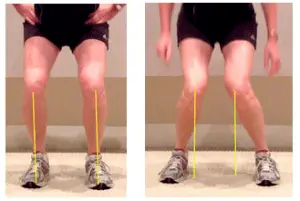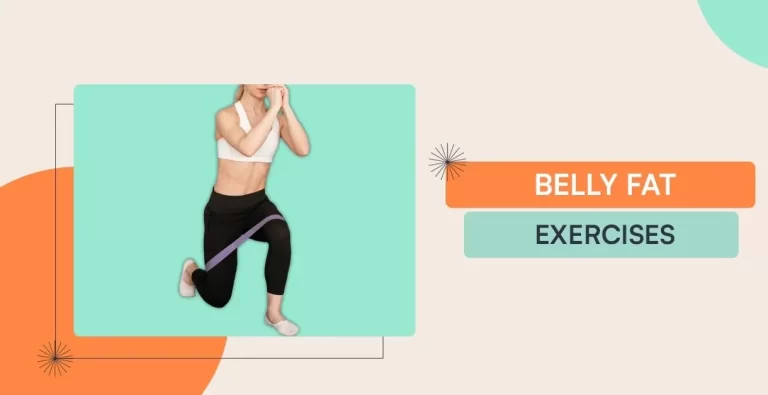22 Best Exercises for Shoulder Tendonitis
Exercises for Shoulder Tendonitis play a crucial role in the recovery process, helping to strengthen the muscles around the shoulder, improve flexibility, and reduce inflammation. With the right exercises, individuals can not only relieve pain but also prevent future injuries, restoring shoulder function and mobility.
Shoulder tendonitis is a common condition that occurs when the tendons in the shoulder become inflamed due to overuse, injury, or repetitive movements. This can lead to pain, stiffness, and a limited range of motion, making daily activities challenging.
To effectively cure shoulder tendonitis, you need to follow your doctor’s instructions, perform rehabilitation Exercises for Shoulder Tendonitis that focus on the entire range of motion, and ensure the joint gets enough rest.
What is Shoulder Tendonitis?
A frequent medical illness known as “shoulder tendonitis,” sometimes spelled “tendinitis,” is defined by inflammation or irritation of the tendons in the shoulder joint.
The rotator cuff, an intricate web of tendons in the shoulder, helps in the mobility and stability of the shoulder joint. Shoulder tendonitis may result from inflammation or irritation of these tendons.
Shoulder tendinitis is a typical injury that occurs in sports where the forearm is used overly, such as tennis, baseball, and swimming. When the arm is raised above the body or twisted, the pain typically arises at the shoulder point and refers to or radiates down the arm. Severe pain will be continuous and may even cause you to wake up from a deep sleep.
Because these activities frequently entail overhead or external rotation, the majority of cases of non-degenerative shoulder tendonitis are caused by a person’s job or preferred sport.
Causes:
Numerous factors can lead to the development of shoulder tendonitis, including:
- Age
Tendons degenerate gradually with age, making them more prone to damage and inflammation. Joint stiffness may be associated with an increased incidence of osteoarthritis in older adults.
- Job
Sports that require a lot of repetition, effort, and certain movement patterns may be harmful. For instance, pitchers in baseball frequently come across it.
- Overuse
Tendinitis can result from repetitive or excessive use of the shoulder joint, as in swimming or tennis, as well as several tasks associated with a job.
- Poor posture
Shoulder tendinitis can be caused by long-term poor posture control, especially when working a desk job.
- Injury
Tendon damage and inflammation might result from an unanticipated accident, fall, or trauma to the shoulder.
Signs and symptoms:
One of the possible signs of shoulder tendonitis is movement pain.
Additional signals consist include;
- Stiffens the shoulder joint and causes difficult movement.
- When moving the shoulder, some people may hear snapping or clicking noises.
- Inflammation and soreness surrounding the injured region.
- Chronic pain in the shoulder, especially with arm lifts or movements.
- Decreased strength in the shoulders.
Advantages of exercises:
People with shoulder tendonitis can benefit from exercise in several ways. Exercise can help control and improve the disease when done properly, but it’s crucial to do it cautiously and under the supervision of a doctor or physical therapist.
- Strengthening of Muscles
To treat shoulder tendonitis, it is essential to strengthen the muscles surrounding the shoulder joint. Stronger muscles are better able to support the shoulder joint and lessen some of the load on the tendons during movement. Resistance and targeted strength training help to increase muscle strength.
- Reduction of Pain
Exercising can help lessen shoulder tendonitis pain when done properly and gradually. Targeted exercise can improve shoulder joint support and lessen the load on the inflamed tendon by strengthening the muscles surrounding the injured tendons.
- Increased Flexibility
Exercises targeted to promote mobility and flexibility can help to improve the flexibility of the shoulder joint. Your capacity to carry out routine duties and activities without experiencing pain may improve as a result.
- Improved Capabilities
For patients with shoulder tendonitis, full restoration of shoulder function is usually the final result of treatment. You can restore your strength and function with the help of progressive and moderate exercises, which will allow you to get back to your regular daily tasks and, in certain situations, sports or social activities.
- Improved Standard of Living
For people with shoulder tendinitis, exercise can significantly improve their quality of life by reducing pain, expanding their range of motion, and recharging capabilities. Thanks to exercise, they can participate in engaging hobbies and work on their daily occupations with less pain.
Exercises for Shoulder Tendonitis:
Shoulder pulley
- While seated directly below the shoulder pulley, attach it to the door.
- With your palms facing each other, hold the pulley at both ends.
- By pulling the handle down to and over the knee with your “good” hand, you may raise your right arm.
- Elevate and maintain your rigid arm as high over your head as you can.
- Then return to your neutral position.
- Then relax.
- Repeat this exercise 5-10 times a day.
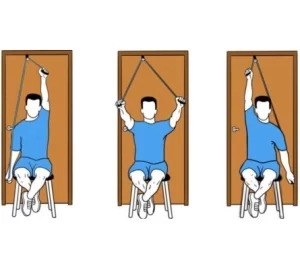
Finger walk
- The patient is standing and facing a ladder that is leaning against a wall.
- Suggest that they place their affected hands gently on the ladder’s low step.
- Then, slowly make your way back to the starting point by reaching the top of the finger ladder.
- Then return to your neutral position.
- Then relax.
- Repeat this exercise 5-10 times a day.

Wand flexion
- Select a peaceful location on the ground to begin with.
- You ought to put your hands shoulder-width apart when gripping a stick.
- Stretch your arms out in front of you with caution.
- While you relax the affected arm, let your unaffected arm elevate your affected arm.
- Move carefully as you complete the moves.
- Hold this position for a few seconds.
- Slowly drop your arms.
- Then return to your neutral position.
- Then relax.
- Repeat this exercise 5-10 times a day.
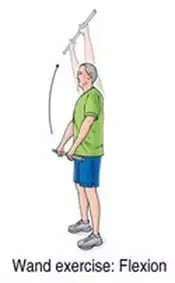
Wand extension
- Initially, make an effort to get yourself on the ground in a comfortable standing position.
- Take hold of a stick with both hands behind your back.
- Make a backward motion with the stick.
- Hold this position for a few seconds.
- Then return to your neutral position.
- Then relax.
- Repeat this exercise 5-10 times a day.
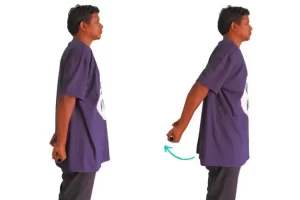
Shoulder abduction and adduction
- Start from a relaxed standing stance on the floor.
- Use both hands to grasp a stick.
- Take the stick and squeeze it between your front thighs.
- As much as you can, use one arm to push the other arm up and to the side while keeping your elbow straight.
- Then return to your neutral position.
- Then relax.
- Repeat this exercise 5-10 times a day.
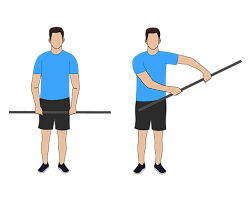
Pendulum
- Take a standing stance on the ground to begin.
- You can maintain your center of gravity on a counter or table as you go.
- You should leave the other arm swinging by your side.
- Make a gentle back-and-forth swing with your arm.
- Before moving it in a circular motion, step your arm from side to side while repeating the exercise.
- Then return to your neutral position.
- Then relax.
- Repeat this exercise 5-10 times a day.
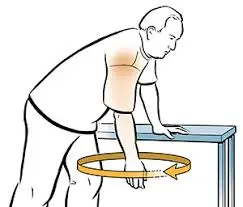
Standing Row
- Take a comfortable standing position on the ground to start.
- Your shoulder should feel extended in the back.
- Tie the ends of the elastic band into a three-foot loop and secure it.
- Secure the loop onto a sturdy object, like a doorknob.
- Hold the band as you stand with your elbow bent and by your side.
- Move your elbow back straight, taking care to keep it close to your side.
- Pull with your shoulder blades pressed together.
- Then return to your neutral position.
- Then relax.
- Repeat this exercise 5-10 times a day.
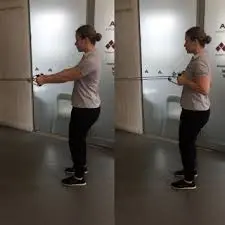
Scapula squeeze
- Stand with your back straight and your arms at your sides, palms facing forward.
- Put your shoulder blades together lightly and squeeze them toward your back.
- For a few seconds, maintain this posture.
- Take a deep breath and release.
- Then return to your neutral position.
- Then relax.
- Repeat this exercise 5-10 times a day.
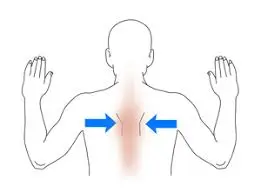
Passive Internal Rotation
- Take hold of the stick behind your back with one hand and grasp it firmly at the opposite end.
- To passively stretch the shoulder until it feels pulled but is not uncomfortable, move the stick horizontally as shown.
- Hold this position for a few seconds.
- Then return to your neutral position.
- Then relax.
- Repeat this exercise 5-10 times a day.
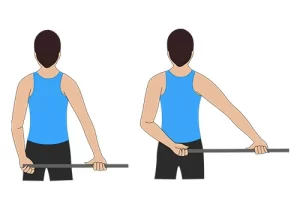
Side-lying external rotation
- Lay on your side on the floor or on a bed.
- Keeping your elbow 90 degrees bent and your forearm pressed palm down against your chest, rest your upper arm by your sides.
- Rotate your shoulder outward to raise your forearm until it is level with your shoulder.
- Hold this position for a few seconds.
- Lower your hand gradually.
- Then return to your neutral position.
- Then relax.
- Repeat this exercise 5-10 times a day.
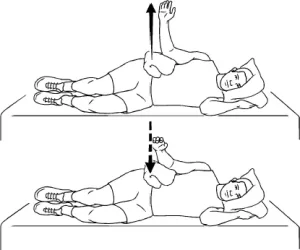
Horizontal abduction
- With your injured arm hanging over the side of the bed or table, lie on your stomach.
- Gently raise your arm to eye level while keeping it straight.
- Hold this position for a few seconds.
- Slowly drop your arms.
- Then return to your neutral position.
- Then relax.
- Repeat this exercise 5-10 times a day.
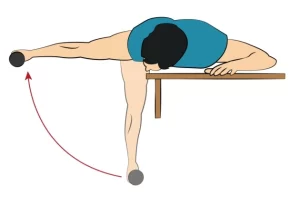
Arnold Press
- Decide on the ideal weight for you and take a ground stance.
- With your hands pointing inward, use a neutral grip to lift the dumbbells off the ground.
- In a safe and controlled manner, set each dumbbell to its correct place.
- Turn your palms so they are facing you after you have the dumbbells in place.
- Learn the weights overhead with your elbows while inhaling deeply and contracting your deltoids.
- Turn the dumbbells so that your hands face-front as you press.
- Depending on the length of your limbs, this will result in the arms being about 90 degrees lower or somewhat lower.
- Then return to your neutral position.
- Then relax.
- Repeat this exercise 5-10 times a day.

Shoulder shrug
- First, choose a comfortable spot on the ground to stand.
- Take a deep breath, then raise your shoulders to your ears.
- As you return your shoulders to their natural position, squeeze your scapulae together.
- Exhale and let your shoulders drop.
- As you reach your elbows forward, notice how your shoulders are stretched.
- Then return to your neutral position.
- Then relax.
- Repeat this exercise 5-10 times a day.
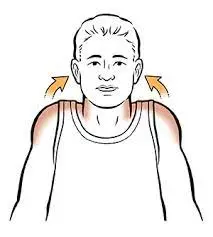
Prone Rows
- Lying on your front, take hold of the dumbbell with an underhand grip.
- Retracting your shoulder blades, bring the dumbbell to the bench.
- Hold this position for a few seconds.
- Once your arms are fully extended, carefully lower the dumbbell.
- Do not hurry the motion; instead, keep it calm and gradual.
- Then return to your neutral position.
- Then relax.
- Repeat this exercise 5-10 times a day.
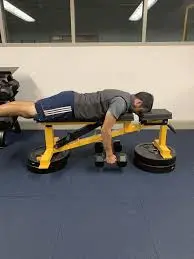
Cross-over Shoulder Stretch
- Initially, find a comfortable spot on the ground.
- Raise and reach your right arm toward your chest.
- Hold your arm with your left hand, or place it in the opening created by your left elbow.
- Hold this position for a few seconds.
- Then return to your neutral position.
- Then relax.
- Repeat this exercise 5-10 times a day.
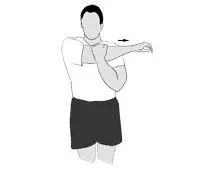
Quadruped Thoracic Rotation
- Begin by putting yourself in the quadruped position on the floor or an exercise mat.
- Your knees should be beneath your hips and your hands squarely beneath your shoulders.
- Verify that your back is in a neutral posture and that your lower back has a slight natural curve.
- Hold one hand behind your head so that your elbow is pointed sideways. This is where you will begin.
- Lean your elbow forward and slowly twist your upper body.
- While maintaining the stability of your lower back and hips, concentrate on rotating through your thoracic spine.
- Keep your lower back from twisting or overarching.
- Rotate in this manner until your upper back and shoulder region experience some stretch or slight strain.
- Take a few moments to hold the final position while maintaining your balance and feeling the stretch.
- Then return to your neutral position.
- Then relax.
- Repeat this exercise 5-10 times a day.

Sleeper stretch
- If you are lying on your side on a flat surface with your affected arm resting on a work surface, flex your elbow to a 90-degree angle.
- Then, progressively apply pressure on your forearm with the opposing arm.
- Hold this position for a few seconds.
- Then return to your neutral position.
- Then relax.
- Repeat this exercise 5-10 times a day.
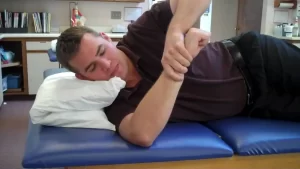
Resistance Internal Rotation
- Choose a band that has the right strength.
- Around an elbow height, fasten the band.
- As you lift your arms, point your left shoulder toward the band.
- Bend your right elbow to around ninety degrees and use your left hand to get a neutral grasp on the band.
- As you exhale, rotate your arm and pull the band as far as you can.
- Hold this position for a few seconds.
- Breathe in and smoothly go back to the beginning position.
- Then return to your neutral position.
- Then relax.
- Repeat this exercise 5-10 times a day.
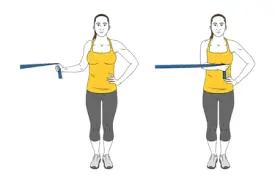
Resistance external rotation
- Put both of your feet hip-width apart on the floor.
- An underhand grip (palms upward) is used to hold one end of a band in each hand after folding it in half horizontally.
- With your elbows bent so that your forearms are parallel to the floor, place your arms so they are in close touch with your sides.
- Bring your shoulder blades down and back softly to straighten your chest.
- Take a breath.
- Pull your forearms outward while attempting to keep your shoulders as stable as possible to increase the tension in the band.
- There should be a little pressure behind your shoulders and in the space between your shoulder blades.
- Hold this posture for a few seconds.
- Then return to your neutral position.
- Then relax.
- Repeat this exercise 5-10 times a day.
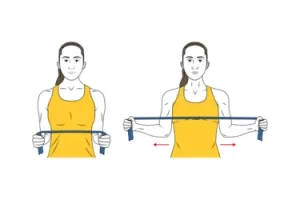
Doorway stretch
- Assume a position where your back is against a wall and your face is toward a room corner.
- With your fingers pointing upward, flex your elbows and shoulders to a ninety-degree angle.
- Keep your elbows at shoulder height and press one hand against each wall.
- You should extend your chest in this manner.
- Hold this position for a few seconds.
- Then return to your neutral position.
- Then relax.
- Repeat this exercise 5-10 times a day.

Wall Angels
- Trying to keep your buttocks and upper back in contact, place your feet a few inches away from the wall while standing with your back to it.
- To prevent getting a severe low back arch, push your abdomen toward the wall.
- Try to push your forearms against the wall by bringing your elbows up to a 90-degree angle and pointing your hands upward.
- Lift your arms up against the wall and move them slowly, softly.
- Hold this position for a few seconds.
- Then return to your neutral position.
- Then relax.
- Repeat this exercise 5-10 times a day.
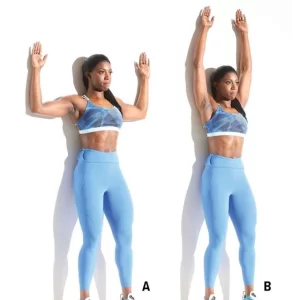
Resistance Band Biceps Curl
- Start by placing your feet hip-width apart in the center of a resistance band and grasping one end of the band in each hand with the palms facing the front.
- Maintain an upright posture, a raised chest, and relaxed shoulders.
- Contract your core for balance while keeping your arms fully extended out to the sides.
- By bending your elbows and moving your hands towards your shoulders, gently curl the band upwards while exhaling.
- When the exercise reaches its peak, squeeze your biceps and hold the position for a few seconds.
- Extend your arms and take a breath as you slowly lower your hands back to the beginning position.
- Then relax.
- Repeat this exercise 5-10 times a day.
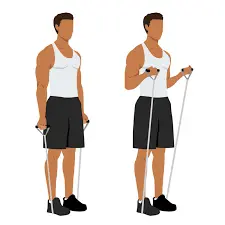
What safety measures are necessary when exercising?
- When starting any exercise, stretch and warm up.
- Before working out, eat something light. Avoid eating right after exercising while avoiding exercising when you’re hungry.
- Make slow, gentle bends and stretches.
- When you exercise, maintain a straight posture.
- Stretching the stiff muscles in your joint is normal and necessary, but it could be difficult. Since it is unhealthy and exacerbates your sickness, exercise, and stretching shouldn’t pain or make you feel as though someone is stabbing you.
- Wear loose, casual clothing that promotes relaxation and maximal range of motion for the best possible training experience. Avoid wearing tight or extremely stylish apparel.
- Try to stay away from sudden or forceful motions when working out.
- Stretching should be performed in line with the protocol both before and after sets, in addition to performing the recommended number of repetitions for each exercise.
- Refrain from taking on challenging tasks.
- Between exercise sessions, take a rest.
- If a certain movement causes you pain, record how this movement gets better each week to monitor your progress.
- Stay hydrated.
- Stop immediately if the pain becomes severe.
What time will you stop exercising?
- Fever
- Headache
- Intense muscle burning.
- You’re not feeling well.
- If there is pain or numbness.
- If exercising hurts, you should stop.
FAQ:
What is tendinitis in the shoulder?
Inflammation or irritation of the tendons in the shoulder joint, especially those of the rotator cuff muscles, is referred to as shoulder tendonitis, also known as rotator cuff tendonitis. Pain, discomfort, and limited range of motion are possible outcomes.
Is surgery required for tendinitis in the shoulder?
Surgery is usually only advised as a last option for treating shoulder tendonitis when non-invasive therapies are ineffective. Surgery is not necessary to treat shoulder tendonitis in the majority of instances.
I have pain from shoulder tendinitis; can I use heat or cold therapy?
Some people with shoulder tendonitis may find relief from their symptoms by using heat to help relax their muscles and increase blood flow. Ice therapy, also known as cold therapy, can ease pain and reduce inflammation. To find out which therapy is best for what you are going through, speak with a doctor.
What part does physical therapy play in the management of tendinitis in the shoulders?
A common essential part of treating shoulder tendonitis is physical therapy. In addition to lowering discomfort and inflammation, a physical therapist can offer exercises and strategies to increase shoulder strength, flexibility, and range of motion.
Can someone with shoulder tendinitis still play sports or participate in physical activities?
It’s crucial to get advice from a healthcare professional on your ability to engage in physical activity or sports. You may be able to manage your condition and continue with some activities while adhering to a rehabilitation program and making necessary modifications to your daily routine.
Which variables are the main causes of shoulder tendonitis?
Poor posture, aging, activities involving repeated shoulder motions, repetitive overhead arm movements (such as in tennis or swimming), and a history of shoulder injuries are common risk factors.
Does treatment-free self-healing occur for shoulder tendonitis?
When treating minor shoulder tendonitis, resting and avoiding aggravating activities can sometimes cause the problem to improve on its own. However, to reduce pain and encourage healing, more severe or persistent instances frequently need to be treated.
If shoulder tendonitis is left untreated, are there any potential complications?
If left untreated, shoulder tendonitis can result in degenerative changes such as rotator cuff tears, which may need surgery, as well as chronic pain and loss of shoulder function.
Can someone with shoulder tendinitis still exercise?
Getting advice on exercising from a physical therapist or healthcare professional is imperative. Rehabilitative programs and adapted workouts may occasionally be able to control and alleviate shoulder tendinitis.
Is it possible to avoid shoulder tendonitis?
It can be reduced or avoided by avoiding repetitive motions with the overhead arms, keeping the right posture, employing safe lifting practices, and warming up before working out.
References:
- Patel, D. (September 29, 2023c). Samarpan Physio: 53 Greatest Shoulder Tendonitis Exercises. Samarpan Clinic for Physiotherapy. The following website has the very top 53 shoulder tendonitis workouts: https://samarpanphysioclinic.com/
- Hyderabad et al. (2021, June 16). Hyderabad, S. C. Shoulder The condition Activities For Shoulder Relief Of Pain | Shoulder Clinic Hyderabad. Shoulder Care Hyderabad – Simply Other WordPress Site. Squeeze your shoulder blades back like you would other exercises to relieve shoulder pain (https://hyderabadshoulderclinic.com/shoulder-tendonitis-exercises-for-relief/#:~:text=.
- Exercises & Stretches for Shoulder Tendonitis: 12. (As of now). Feel Well. Exercises for Shoulder Tendonitis at https://www.vivehealth.com/blogs/resources
- Image 14, WebArcherySchool.com. Jan. 9, 2023. Anterior Rows. Academy of Online Archery. www.onlinearcheryacademy.com/prone-rows
- Image 18, Internal rotation of resistance bands: Exercise regimens. (n.d.). The resistance band internal rotation exercise is available at https://www.workoutsprograms.com.
- Image 22, October 9, 2022, KFAdmin. How to Choose the Best Resistance Band for Workouts. Visit https://www.keepufitness.com/ to learn how to choose a resistance band for your workout.






